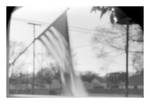Photography Week
Pinhole cameras are the most basic cameras possible, just a tiny hole, film or sensor to capture the image, and a light-tight box to hold it all together. That's it. You set the camera where you want it, uncover the hole for whatever time feels right, re-cover the hole, and go on your way. You process the film or digital image just as you would for any other camera.
Why shoot with a pinhole camera? For some it's their rebellion against all the camera porn and acquisitiveness promoted by camera magazines and people with more money than good sense, against the notion that more expensive equipment will make one a better photographer. For others it is the simple joy of using the most basic camera possible. Some are enamored with the magic of the slightly fuzzy images with infinite depth of field. For most of us it's a mixture of things. And it's liberating and just plain fun to leave behind all the complicated stuff and let it be just me, the camera, and the world. When I find myself getting bored with my photography, it's time to grab the pinhole camera and go play.
There are three approaches to coming up with a pinhole camera.
- You can buy one. I have put many rolls of 120 film through my Holga Pinhole Camera. I've experimented with using it with 35mm film. It's a pretty good camera, much classier than its plastic-lens cousin. I payed US$18 a few years ago for the camera, and I think that included a roll or two of film. I would love someday to get a Zeroimage, such as Epytafe uses, with its cabinetry quality box and precision pinhole, but I don't have the couple or few hundred dollars right now that one would set me back. I include building a pinhole camera from a purchased kit in this category.
- You can build your own from scratch, with anything from matchboxes to shoeboxes to tin cans or whatever your heart desires. rdungan1918 has made some very fine cameras from foam board. Scratch-built cameras are generally single shot affairs; you load and unload the film in a photographer's black bag. If you want to take more than one image, carry more than one camera.
- You can convert an existing camera to pinhole. This is the route I took. I have three Argus C3 bricks sitting on my shelf, one with the stock 50mm lens, one with a 35mm lens, the last with a 100mm lens. (Swapping lenses on a C3 is not what I would consider a field operation, and the bodies are cheap.) As I had an extra in the basement with something of an oddball setup and a flaky lens, I decided to use it to add a pinhole to the collection.
With the glass out of the way I was able to disassemble the lens and look for ways to mount a pinhole in the frame. I found a couple of candidates. Next step was to make the pinhole.
The instructions typically recommend a foil pie tin. I did a quick check. We didn't have any. We did, however, have a fine collection of empty (and full) Genesee Cream Ale cans. ("Not bad for cheap beer," goes the mantra.) I cut a square out of one of the green areas, thinking I would get less internal reflections that way.
Next I took one of the pieces of the dismantled lens assembly, set the metal square on it, and pressed down to make a circle impression in the metal. I used my good scissors to cut off the excess. (I figure the soft metal would be easier on the scissors than paper or cardboard.) I set the cutout circle on a piece of cardboard and gently pushed a sewing needle through, as close to the center as I could, and just enough to give me a hole that seemed about the same size as on my Holga Pinhole. I pressed the hole flat on my desk to flatten the flange, then wiggled the needle in it to clean it and try to make it round, and flattened it again.
The next step was to mount the pinhole in the lens assembly. There were two pieces near the front of the assembly that I could screw together tightly enough to keep the pinhole stable, so that's where it went. I reassemble the lens and mounted it on the camera.
I loaded a roll of castoff and long-expired color film in the camera and went for a walk. I tried a variety of shots with a variety of exposures in the range of a few seconds, pretty much what I would have used with the Holga. Twenty four frames later, I came home, went down to the basement, and developed the film, cross-processing it with D76. I wasn't concerned with getting good photographs at this point as I was in seeing if the thing even worked and whether the exposure times were reasonable.
As it turned out, the exposure times were ok, but the pinhole placement was not. I had it too far forward, with the result that the shutter leaves were visible in the images. And it was not well centered. So I took everything apart again, found a further-back place where I could mount a pinhole, cut and drilled a new piece of beer can metal, and put it all back together. This time I pretty much got it right.












